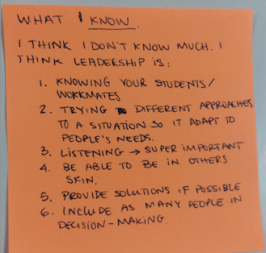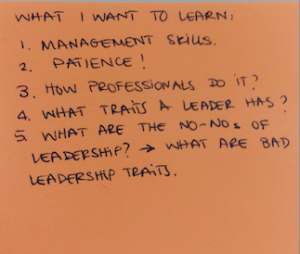Leadership, too, is an art. It cannot be taught, because it requires talent. Although talent cannot be transmitted from one to another, others can help recognise and develop it. Such recognition and development should be a major objective of education.
The word art has at least two related but different meanings. In one, it is virtually synonymous with skill, as, for example, when we speak of the art of furniture making or the art involved in architecture. In this sense, the terms arts and crafts are also almost synonyms. A craft is an activity that produces a product that has artistic (aesthetic) qualities but these are not primary. Their utility function is primary. For example, a chair designed by Eames or Saarinen is first a thing on which to sit, and second, a work of art. On the other hand, some works of (fine) art have no utility, their primary purpose being aesthetic (for example, a symphony by Beethoven, a painting by Cezanne, a sculpture by Rodin, or a play by Shakespeare).
The division between the fine arts and crafts is not a fine line but a grey area. This is why many art museums also display crafts such as furniture and pottery.
Production of great art and craft works always involve skill, but having the requisite skill is not sufficient; talent is also required for greatness. Different fine arts and crafts require different talents as well as skills.
The two functions of aesthetics, as I understand them, are first to inspire the pursuit of ideals, its creative function. An ideal is an objective that can never be attained but can be continually approached. The second function is to stimulate a disposition to continuously pursue ideals, its recreative function. The recreative function provides pleasure in the pursuit itself. It provides “the pause that refreshes”. Without such refreshment, continual pursuit of something that can never be obtained is not sustainable.
The recreative function of art is embedded in entertainment. This is why we often refer to entertainers as artists. However, an entertainer is not the same kind of an artist that a Beethoven or a Cezanne was. Lucy and Sinatra entertained, they did not inspire, but Beethoven and Cezanne still do.
One may acquire a skill by practice (for example, by riding a bicycle). Acquisition of a skill can, in some cases, be facilitated by instruction. Most people can be taught to draw, and in some cases to do so well. But, there is no way to teach someone how to be a great graphic artist. The skills involved in producing fine art or in producing artistic crafts can be developed forms scratch, but not the talents required. Although talent cannot be taught, it can be nurtured and developed.
Most people, young or old, have some kind of talent, artistic or otherwise. However, few have many different artistic talents (Michelangelo and Da Vinci were exceptions). For example, a great composer might not be able to produce a great painting or vice versa. Therefore, one of the most important functions of education at all levels is to enable individuals to discover what talent or talents they have had, once discovered, to learn how to develop it or them.
A talent can only be discovered through practice (Written examinations cannot do it). For example, we can only find out if we have a talent for painting or writing by painting or writing. Therefore, effective education should provide “students” of all ages with opportunities to explore a wide range of arts and crafts, and thus, enable them to find out for which ones they have a talent.
The effective uncovering of talent cannot be directed by others; only by self-direction. However, it can be facilitated and enhanced by others. Artistic standards should never be externally imposed on learners. Where they are, great artists such as van Gogh go undiscovered for much too long. Most great artists go unappreciated by those who set and preserve standards of quality in art. Breaking rules is an essential part of artistic creation. The initial presentation of great works of art […] have even created overt hostile reactions by audiences. Even when great artists form a ‘school’, as the impressionists did, each individual member is unique and produces works whose creator can easily be identified by the work.
A vision of an ideal, or approximation to it, attracts and mobilises followers who are willing to pursue that vision even if it requires personal sacrifices to do so. The ability to articulate a vision is also a requirement of leadership. A leader need not to be the author of a mobilising vision, only the articulator of it. And a leader must be able to do so in such a way as to attract followers by inspiring them. Robert Hutchins formulated Mortimer Adler’s vision. Hutchins was the leader, not Adler. Followers are attracted to a vision because it is one they share even if they have not been able to articulate it as well as the leader has. Articulation of an inspiring vision is a work of art and is an essential part of leadership.
A leader must also be able to articulate a strategy for pursuing the vision a way that promises the possibility of progress toward realisation of the vision. Fine artists do not necessarily have this ability, but leaders must have it. For example, van Gogh certainly produced a new vision of what painting could be, but he was hardly a leader. Some attract followers by example. Innovators are often imitated but they do not lead.
Without the requisite talents – to articulate an inspiring vision and a strategy for pursuing it effectively – one cannot become a leader. Therefore, most so-called leadership-development programs are shams; they make a false promise: to make leaders out of managers or administrators. They are based on the failure to distinguish between administrators, managers, and leaders.
Administrators are ones who direct others in the pursuit of ends by the use of means, both of which have been specified by a third party. For example, one who supervises a group of clerks who perform a routine task such as order entry or preparation of purchase orders is normally an administrator. What his or her subordinates do has been specified by an authority higher than their immediate boss, the supervisor. In general supervisors are administrators. Government is fill of administrators because the bureaucracy of which they are part usually specifies the ends and means to be employed by those who must do the actual work.
A manager is one who directs others in the pursuit of ends by the use of means that the manager selects. Many who are called managers, even in the private sector, are really administrators. The more autocratic an organisation, the fewer managers and more administrators. The more democratic an organization, the more managers and fewer administrators.
A leader is one who directs others in the pursuit of ended by the use of means that those he leads selects, in the sense that those who follow a leader do so voluntarily. Those who are followed involuntarily, because they can exercise authority over the followers by punishing them for noncompliance, are commanders. A commander is a type of manager, NOT a leader. For example, Joan of Arc was a leader, because she could exercise no authority over her followers. But General Patton was a commander, a military manager, not a leader. He ruled by authority.
Leadership is a practice, not a subject, as these were previously defined. As a practice as well as an art, leadership cannot be taught. If the requisite talent is present, leadership can be developed, but not without it. As a practice, it is best learned either through self-motivated explorations or through apprenticeship with one who has and can demonstrate the requisite talent and skills.
Schools – preschool and kindergarten through universities – can nurture leadership where the requisite talent exists, but they cannot produce it. They can help identify and develop the necessary skills and thereby improve the quality of management. This is equally true of continuing post-school, adult education. Nurturing leadership requires providing opportunities for the requisite talent to reveal itself, recognizing it when it does, and helping talent (and the skills that must accompany it) to develop.
Ackoff, R., & Greenberg, D. (2008). The Place of the Arts. In Turning Learning Right Side Up: Putting Education Back on Track. Prentice Hall.



